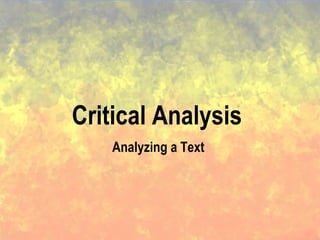Rhetorical analysis
•Als PPT, PDF herunterladen•
4 gefällt mir•3,896 views
ENGL 1301 - Guide to writing a textual/rhetorical analysis
Melden
Teilen
Melden
Teilen

Empfohlen
Weitere ähnliche Inhalte
Was ist angesagt?
Was ist angesagt? (20)
Andere mochten auch
Andere mochten auch (7)
Ähnlich wie Rhetorical analysis
Ähnlich wie Rhetorical analysis (20)
Evaluation of Text and Images in Multicultural Context

Evaluation of Text and Images in Multicultural Context
Statement of explanation expository compare contrast 

Statement of explanation expository compare contrast
DIDLS The Key to TONE Diction - the connotation of the wo.docx

DIDLS The Key to TONE Diction - the connotation of the wo.docx
Essay writing checklist by Mahfoudh Hussein Mgammal

Essay writing checklist by Mahfoudh Hussein Mgammal
Kürzlich hochgeladen
God is a creative God Gen 1:1. All that He created was “good”, could also be translated “beautiful”. God created man in His own image Gen 1:27. Maths helps us discover the beauty that God has created in His world and, in turn, create beautiful designs to serve and enrich the lives of others.
Explore beautiful and ugly buildings. Mathematics helps us create beautiful d...

Explore beautiful and ugly buildings. Mathematics helps us create beautiful d...christianmathematics
Kürzlich hochgeladen (20)
Measures of Central Tendency: Mean, Median and Mode

Measures of Central Tendency: Mean, Median and Mode
Measures of Dispersion and Variability: Range, QD, AD and SD

Measures of Dispersion and Variability: Range, QD, AD and SD
General Principles of Intellectual Property: Concepts of Intellectual Proper...

General Principles of Intellectual Property: Concepts of Intellectual Proper...
Explore beautiful and ugly buildings. Mathematics helps us create beautiful d...

Explore beautiful and ugly buildings. Mathematics helps us create beautiful d...
Unit-V; Pricing (Pharma Marketing Management).pptx

Unit-V; Pricing (Pharma Marketing Management).pptx
This PowerPoint helps students to consider the concept of infinity.

This PowerPoint helps students to consider the concept of infinity.
Role Of Transgenic Animal In Target Validation-1.pptx

Role Of Transgenic Animal In Target Validation-1.pptx
Seal of Good Local Governance (SGLG) 2024Final.pptx

Seal of Good Local Governance (SGLG) 2024Final.pptx
Rhetorical analysis
- 1. Critical Analysis Analyzing a Text
- 2. Rhetorical Context • Background of the author –What makes the author reliable or credible? –Is the writer writing within his or her area of expertise? –Does the author identify with a particular group or set of beliefs? –What experience does he or she have? –Is the author a writer by profession? • Why is that significant?
- 3. • Type / Genre of the Source – Is it a researched and documented essay by a specialist? – Is it the text of a speech delivered to a specific audience? – Is it an editorial or an op-ed piece? – Is it a syndicated column, political cartoon, or comic strip? • Why is that significant? Rhetorical Context
- 4. • Intended Audience – Who was the article meant for? – Does the author expect a popular audience? A general but educated audience? A specialist audience of shared expertise? – Does the author anticipate an audience that share cultural, political, or religious values? – What type of audience was it? Supportive? Sympathetic? Skeptical? Hostile? • Why is that significant? Rhetorical Context
- 5. • Primary Purpose – Is the work primarily informative or persuasive in intent? – Is it designed to entertain or be inspiring? – Does it narrate, describe, illustrate, define, compare, or offer analysis? – What goals does the author identify in his/her thesis statement? • Why is that significant? Rhetorical Context
- 6. • Sources of Information – Where was the information obtained? – Are the sources clearly identified? • Beware of “unnamed” or “reliable” sources – What kind of sources does the author use? – Does he rely on facts and figures? Personal experience? Anecdotal evidence? • Why is that significant? Rhetorical Context
- 7. Style • Diction and Tone – Is the writer using a conversational tone or a more formal style of writing? – Does the writer use slang words or technical words? – Is the word choice concrete and vivid or abstract and intellectual? • Why is that significant?
- 8. • Sentence Structure – Are the sentences generally long or short, or varied in length? – Does the writer use sentence fragments (incomplete sentences)? – Does the writer seem to be using an overly simplistic style? If so, why? – Does the writer use parallelism (coordination) or antithesis (contrast)? • Why is that significant? Style
- 9. • Figurative Language – Does the author make use of metaphors or similes? – What are the items being compared? – What is the point of comparison? – What is the emotional impact of the figurative comparison? • Why is that significant? Style
- 10. • Organization – Where are the ideas placed? The beginning, middle, end? – What does the placement say about the importance of the idea? – What parts of the discussion are developed at length? – What points are treated only briefly? • Why is that significant? Style
- 11. Style • Other things to pay attention to: – Hyperbole (exaggeration), understatement, or irony – Quotation marks, italics, or capital letters – Repetition – Examples
